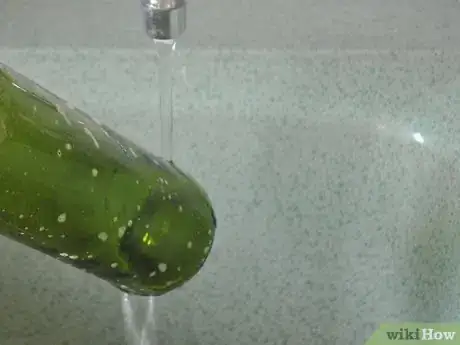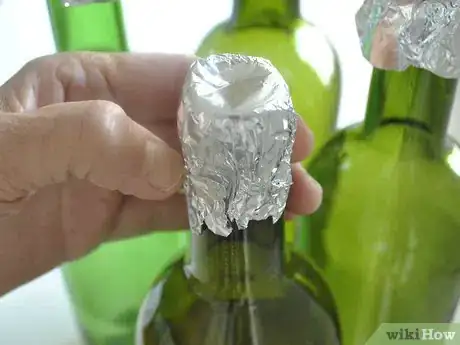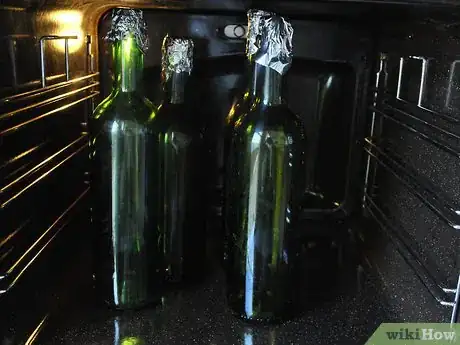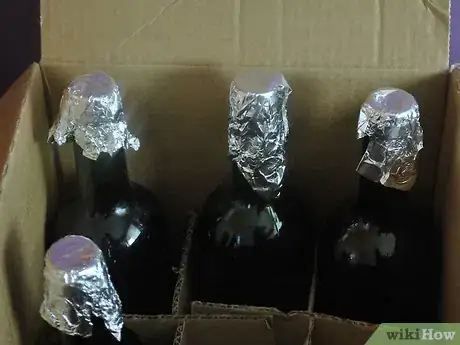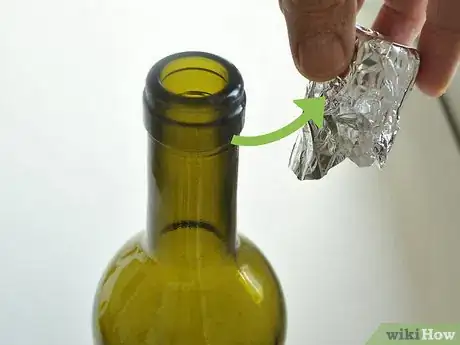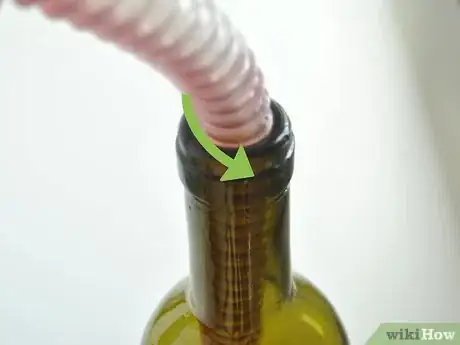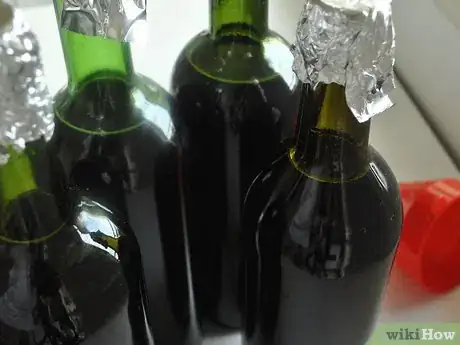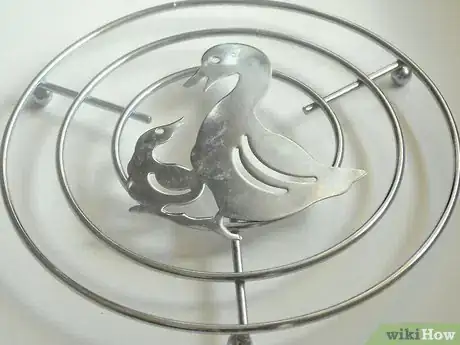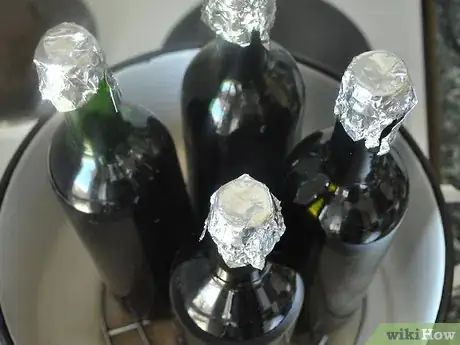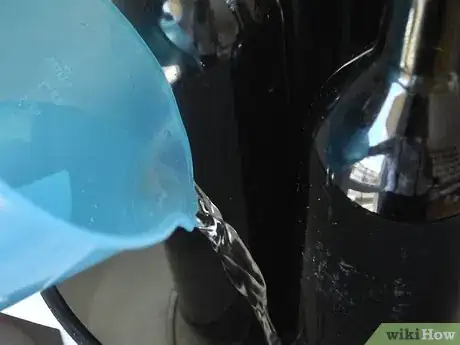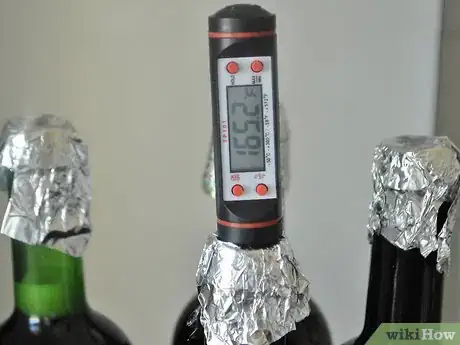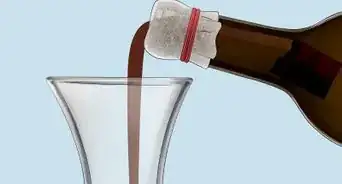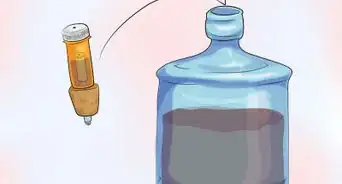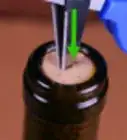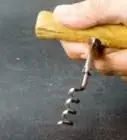wikiHow is a “wiki,” similar to Wikipedia, which means that many of our articles are co-written by multiple authors. To create this article, volunteer authors worked to edit and improve it over time.
wikiHow marks an article as reader-approved once it receives enough positive feedback. In this case, 94% of readers who voted found the article helpful, earning it our reader-approved status.
This article has been viewed 69,748 times.
Learn more...
If the wine maker does not stop fermentation before bottling, then the yeast will continue to produce gases that will increase the internal pressure of the bottle and can make the bottles explode during storage. There are two ways to stop fermentation; one way is by adding chemicals to your wine (sulfites, sorbate, etc.); the other is by using heat. This article will describe how to use heat to stop fermentation, thereby making your wine safe for bottling, by killing the yeast and also, as a bonus, by killing harmful bacteria such as Salmonella, Listeria, and E. coli, which may be present.
Steps
Sterilizing Your Bottles
-
1Wash the bottles. As you use the wine bottles, wash them with soap, water, and a wine bottle brush; then rinse and invert them to dry.
-
2Let them dry. When they're totally dry, wrap a small piece of aluminum foil over each bottle opening to keep anything from getting inside the bottles.Advertisement
-
3Warm them up. When you have a couple of dozen of these cleaned bottles, put them in a cold oven, standing upright; then set the oven to 248°F (120°C), when the oven reaches 248°F (120°C), set a timer for 30 minutes; after 30 minutes shut the oven off and let the bottles cool in the oven overnight, with the door shut.
- Wine bottles are made of soda-lime-silica glass, not borosilicate glass, like Pyrex; therefore, if you take them out while hot, they can break due to thermal shock.
-
4Store the bottles. When the bottles have cooled, put them into a case box (stored upright with the foil still over the top of each bottle) and close the flaps. They remain sterile indefinitely (as long as the foil remains in place) and are ready to go when you need them.
Bottling the Wine
-
1Take one of your empty sterilized bottles. Remove the aluminum foil from the bottle.
-
2Fill the bottle. Using a funnel, or siphoning tube, fill the bottle with wine until the wine level is just above where the neck starts, and then put the aluminum foil back on.
-
3Repeat this process with each bottle until all of the wine bottles are filled. Once the bottles are filled, the next step is to pasteurize the wine in order to completely stop fermentation (if fermentation is not stopped, then the yeast will continue to produce gases that will increase the internal pressure of the bottle and can make the bottles explode during storage).
Pasteurizing the Wine
-
1Put a trivet/pressure cooker rack in the bottom of a tall stock pot.
-
2Place the aluminum-foil-topped bottles of wine on the trivet/pressure cooker rack.
-
3Pour tap water into the pot. The water level doesn’t have to be above the wine level in the bottles, but it should be as high as you can get it safely without it boiling out of the pot.
-
4Place a digital thermometer through the foil and inside one of the bottles.
-
5Heat the bottles. Heat the water until the temperature inside the bottle reaches 165 °F (74 °C). This temperature kills the yeast; this temperature also kills harmful bacteria such as Salmonella, Listeria, and E. coli.
- Once the temperature reaches 165 °F (74 °C), hold it at this temperature for 15 seconds, then immediately remove the bottles.
- Use oven mitts on both hands and grab each bottle, with a tight grip, by the neck with one hand (not the foil, which could cause the bottle to slip out of your hand) and the bottom of the bottle with the other hand; be extremely cautious because the bottles are hot and slippery from the condensation and the wine is hot.
-
6Set the bottles aside on the kitchen counter to cool completely. Keep the foil still in place during this process.
- Note: if pasteurizing multiple batches, you must pour out the heated water from the previous batch. Always start with cool water. Never put bottles into hot water or the glass will break; the bottle and the water must be heated together to prevent thermal shock.
-
7Cork your batch. Once the bottles have cooled, remove the foil from one bottle and cork it; repeat until all bottles are corked. Age some; drink some.
Community Q&A
-
QuestionDoes the alcohol evaporate during pasteurization?
 Community AnswerThe alcohol (ethanol) will evaporate at around 78°C. While some will evaporate, the alcohol vapors will condensate in the bottle and drip back into the wine. It won't be a problem unless you remove the foil seal before it's finished cooling.
Community AnswerThe alcohol (ethanol) will evaporate at around 78°C. While some will evaporate, the alcohol vapors will condensate in the bottle and drip back into the wine. It won't be a problem unless you remove the foil seal before it's finished cooling. -
QuestionYou wrote to heat it up for 25 seconds. Did you mean minutes? I have read a couple articles and they said 15 to 20 minutes.
 ms ChenCommunity AnswerIt was about the temperature - 60°C will need 30 minutes, 72°C will only need 15 seconds.
ms ChenCommunity AnswerIt was about the temperature - 60°C will need 30 minutes, 72°C will only need 15 seconds. -
QuestionHow do I pasteurize a juice?
 Community AnswerHeat the juice to about 70°C (158°F), stirring frequently. Keep it at 70°C for at least 1 minute. This will make sure that all E. coli bacteria, as well as other organisms such as mold, are destroyed. Pour the juice into clean, sterilized preheated bottles.
Community AnswerHeat the juice to about 70°C (158°F), stirring frequently. Keep it at 70°C for at least 1 minute. This will make sure that all E. coli bacteria, as well as other organisms such as mold, are destroyed. Pour the juice into clean, sterilized preheated bottles.
Things You'll Need
- Finished wine ready to bottle
- Wine Bottles
- Wine Corks
- Aluminum Foil
- Stock Pot
- Digital Thermometer
- Trivet/Pressure Cooker Rack
